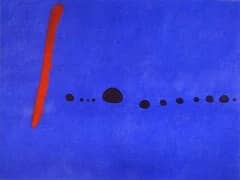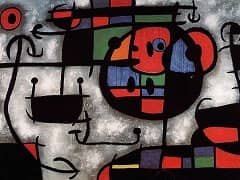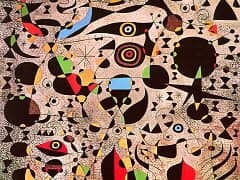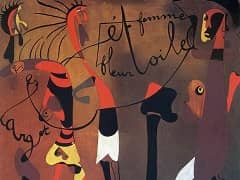Libelle Mit Roten Flugeln Eine Schlange Jagend by Joan Miro

Miro's symbols seem to have inscribed themselves into the spotty brown surface with a brute, elemental forcefulness. Convulsive, crossed or forked lines converge at narrow angles which have been pardy filled, and encircle a centre, characterized by the dense colour of its surface and, above all, by a black splotch which has been hurled onto the canvas. It is surrounded by several emphatically colourful elements - circles, lines and dots in Miro's basic colours red, yellow, green and bluish purple.
Despite its broad movements, the picture does give the impression of being carefully composed, especially when we consider the distribution of symbols around a centre, which almost amounts to a classic method of composition. The multiply broken and sprayed surface seems like a three-dimensional foil on which the symbols are in suspension, without forming a firm part. On the other hand, the general character of the painting is mythical and primaeval - like those early drawings which had always inspired Miro to invent his own symbolic language. The different periods of mankind seem to have converged in these late paintings of Miro's. The earliest has become the latest, and the mythology of our modern age has linked itself to the myths of mankind's history. This picture may indeed contain the evidence that the most elementary symbols have never changed but have always crossed man's conscious mind by re-activating those deeper levels of pre-conscious and pre-linguistic perception.
















